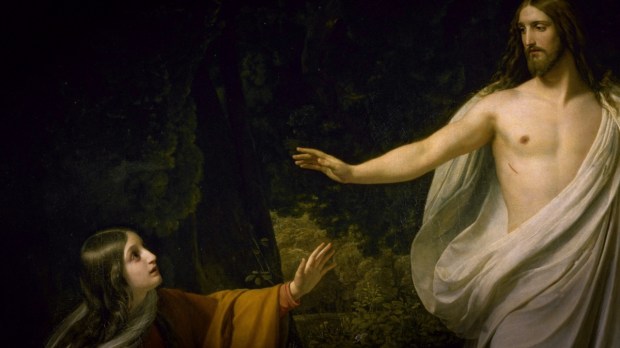Lenten Campaign 2025
This content is free of charge, as are all our articles.
Support us with a donation that is tax-deductible and enable us to continue to reach millions of readers.
On February 1, Pope Francis proposed a great patroness of hope for the Jubilee: Mary Magdalene weeping at the tomb of Jesus — and then turning around.
“The word ‘conversion’ indicates a change of direction,” he says. “Everything can be seen at last from another perspective, and so our steps go towards new goals.”
The way Mary Magdalene saw Jesus on Easter morning has intrigued people for years.
It seems that we all get unique encounters with the Risen Lord.
The apostles needed a lot of evidence — Peter and John see his burial cloths, they all see him in person more than once, but then they still return to their fisherman lifestyle. Even at the Ascension, apostles doubted.
Women seem much more willing to believe. One group of women see his empty tomb, and angels, then meet him on the road and immediately hold onto his feet and worship. All he says at first is “Hail” — and he has them at hello.
But for Mary Magdalene it’s not so easy. Peter and John head home believing; “But Mary stood weeping outside the tomb.”
Even the angels don’t understand why she’s crying, and ask her.
Maybe the tears interfered with what happened next.
She tells the angels, “Because they have taken away my Lord, and I do not know where they have laid him,” and then she stops.
“Saying this, she turned around,” the Gospel says.
I like how St. John Chrysostom describes it.
“Methinks that while she was speaking, Christ suddenly appearing behind her, struck the Angels with awe; and that they having beheld their Ruler, showed immediately by their bearing, their look, their movements, that they saw the Lord.”
Angels don’t have bodies, but you can picture these figures suddenly coming to attention, not like soldiers in a drill line when the sergeant comes, but like pilgrims lining a roadway when the Eucharistic procession comes.
But her lack of faith continues, even when she talks to Jesus.
You have to admire her boldness. She sees a man coming to the tomb early in the morning and she immediately confronts him: “Sir, if you have carried him away, tell me where you have laid him, and I will take him away,” she says.
“Mary speaks the language of love, not even considering whether what she offers to do would be possible for her,” said the theologian Father Bruce Vawter.
Then Jesus says, “Mary,” and like a sheep hearing its shepherd’s voice, she knows him immediately — but she doesn’t worship, like the other women. She says only “Rabboni!” which means “Teacher.”

So her lessons aren’t done.
“It is repeated several times that Mary turned around,’” Pope Francis notes. “The evangelist chooses his words well!”
First, she has to turn from the tomb because “the Risen one is not on the side of death, but on the side of life,” he says. Then she has to turn again when she hears her name.
Mary doesn’t worship Jesus like the other women do, and therefore apparently can’t touch him like they do either. “Do not hold me, for I have not yet ascended to the Father,” he says. Instead, he sends Magdalene to tell the apostles what she has seen.
It is only when she goes on this mission that she gains the faith those other women had. “I have seen the Lord,” she says.
We all need to go through this process.
“Our Risen One takes us into his world, step by step, on the condition that we do not claim to know everything already,” Pope Francis says. “One enters the new world by converting more than once.”
He says to stop “looking into the darkness of the past, into the emptiness of the tomb,” but look toward Christ.
“There is a place for you, for me, for everyone. No one can take it, because it has always been meant for us. ... Everyone can say: I have a place, I have a mission!”
Even a woman with a past like Mary, the one “from whom [Jesus] had cast out seven demons.”
What was her mission, after all that lack of faith?
St. Thomas Aquinas said she was more than a prophet — “she had the dignity or rank of an angel.” She also “had the office of an apostle; indeed, she was an apostle to the apostles.” More than that, “just as it was a woman [Eve] who was the first to announce the words of death, so it was a woman who would be the first to announce the words of life.”
She gained a lot by being willing to second guess herself.
Asks Pope Francis “Do I know how to turn around to see things differently, with a different outlook?”



